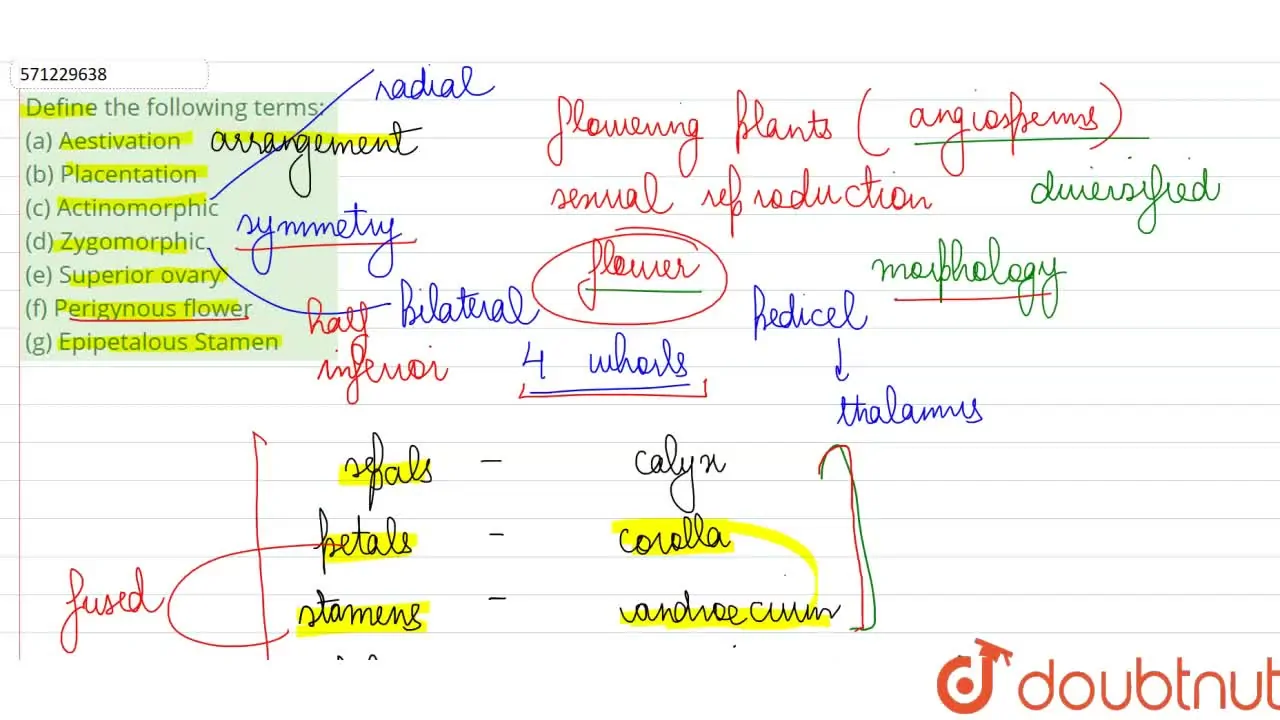Define the following terms:
(a) Aestivation
(b) Placentation
(c) Actinomorphic
(d) Zygomorphic
(e) Superior ovary
(f) Perigynous flower
(g) Epipetalous Stamen
(a) Aestivation
The term ‘aestivation’ refers to the mode in which sepals or petals are arranged in a floral bud with respect to other floral members. There are four types of aestivation in plants i.e., valvate, twisted, imbricate, and vexillary.
(b) Placentation
The term ‘placentation’ refers to the arrangement of ovules within the ovary of a flower. It is primarily of five types, namely marginal, basal, parietal, axile, and free central.
(c) Actinomorphic
Actinomorphic flowers can be divided into two radial halves by any radial plane passing through its centre. Examples of these flowers include chilly and mustard.
(d)Zygomorphic
Zygomorphic flowers are those flowers which can be divided into two similar halves by a single vertical plane. Examples of these flowers include pea and beans.
(e) Superior ovary
Superior ovary flowers are those flowers in which the gynoecium is present at the highest position, while other floral parts are arranged below it. A flower with this arrangement is described as hypogynous. Examples include brinjal and mustard.
(f) Perigynous flower In perigynous flowers, the gynoecium is present in the centre and the rest of the floral parts are arranged at the rim of the thalamus at the same level. Examples include plum and rose.
(g) Epipetalous Stamen Epipetalous stamens are stamens attached to the petals. They are found in brinjal.
Related Playlists
Similar Questions
Define the following terms
superior ovaryView SolutionDefine the following terms
epipetalous stamenView SolutionDefine the following terms
perigynous flowerView SolutionDefine the following terms :
(a) Atoms
(b) Molecules
(c) Radicals
(d) Valency
(e) Periodic tableView SolutionDefine the following terms and give two examples in each case.
(a) Autotrophs (b) Consumers (c) Food chain
(d) Symbiosis (e) Parasitism (f) PredationView SolutionIdentify the wrong statement
(a) A plant that bears male, female and bisexual flowers is polygamous
(b) Actinomorphic flower can be dissected into two equal halves from any plane
(c) Superior ovary is found in hypogynous flower
(d) Side of the flower towards the bract is called posterior sideView SolutionDefine the following terms :
(a) Cell (b) Cell organelle
(c) Mitosis (d) Meiosis
(e) Evolution (f) Crossing -over
(g) Karyokinesis (h) Diploid
(i) InterphaseView SolutionDefine the terms:
a. Gene , b. Genetic code,
c. Transcription, d. Translation
e. CodondView SolutionHow many of the following features are associated with pea? (a) Basal placentation (b) non-endospermous seed (c) leaf sendrilis (d) Moncadalphous stamens (e)papllionaceous corolla (f) Actinomorphic flowers
View SolutionZygomorphic flowers are found in:-
(a) Mustard
(b) Gulmohur
(c) China rose
(d) DaturaView Solution


